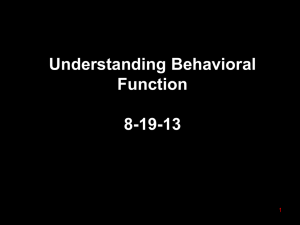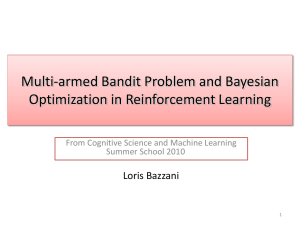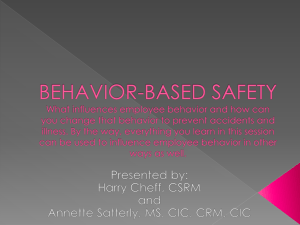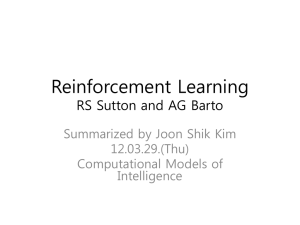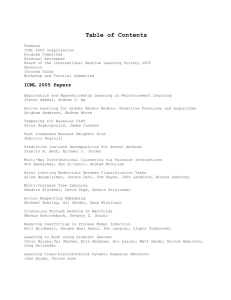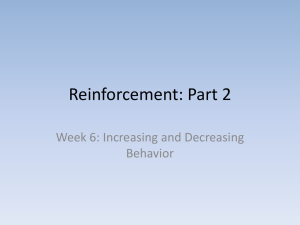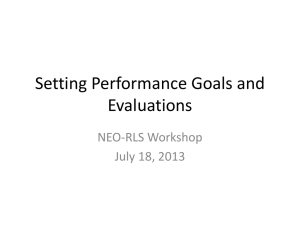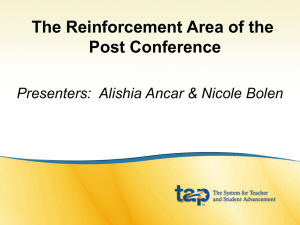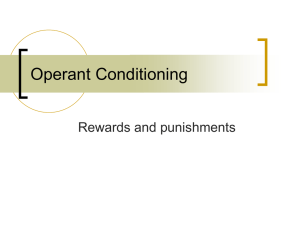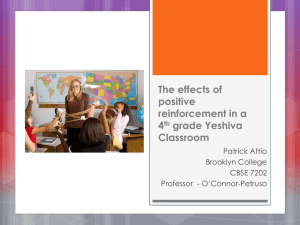Reinforcement Learning for Complex System Management
advertisement
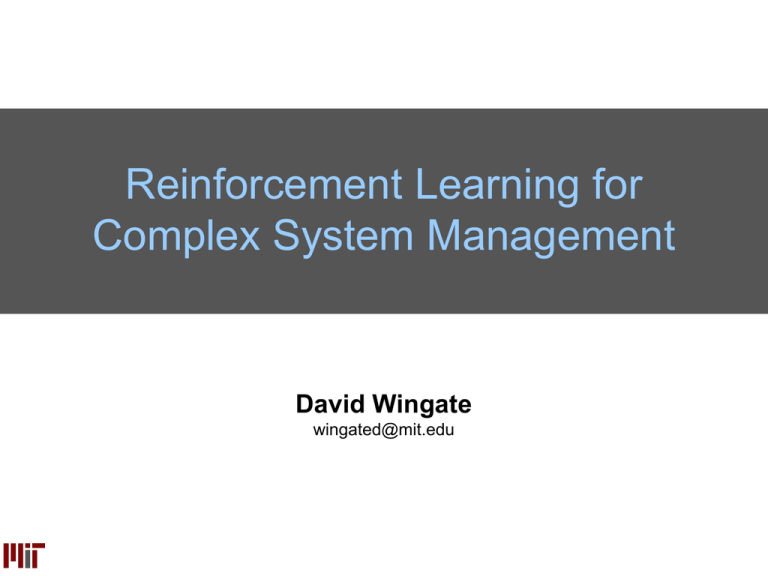
Reinforcement Learning for Complex System Management David Wingate wingated@mit.edu Complex Systems • Science and engineering will increasingly turn to machine learning to cope with increasingly complex data and systems. • Can we design new systems that are so complex they are beyond our native abilities to control? • A new class of systems that are intended to be controlled by machine learning? Outline • Intro to Reinforcement Learning • RL for Complex Systems RL: Optimizing Sequential Decisions Under Uncertainty observations actions Classic Formalism • Given: – – – – A state space An action space A reward function Model information (ranges from full to nothing) • Find: – A policy (a mapping from states to actions) • Such that: – A reward-based metric is maximized Reinforcement Learning RL = learning meets planning Reinforcement Learning RL = learning meets planning Logistics and scheduling Acrobatic helicopters Load balancing Robot soccer Bipedal locomotion Dialogue systems Game playing Power grid control … Reinforcement Learning RL = learning meets planning Logistics and scheduling Acrobatic helicopters Load balancing Robot soccer Bipedal locomotion Dialogue systems Game playing Power grid control … Model: Pieter Abbeel. Apprenticeship Learning and Reinforcement Learning with Application to Robotic Control. PhD Thesis, 2008. Reinforcement Learning RL = learning meets planning Logistics and scheduling Acrobatic helicopters Load balancing Robot soccer Bipedal locomotion Dialogue systems Game playing Power grid control … Model: Peter Stone, Richard Sutton, Gregory Kuhlmann. Reinforcement Learning for RoboCup Soccer Keepaway. Adaptive Behavior, Vol. 13, No. 3, 2005 Reinforcement Learning RL = learning meets planning Logistics and scheduling Acrobatic helicopters Load balancing Robot soccer Bipedal locomotion Dialogue systems Game playing Power grid control … Model: David Silver, Richard Sutton and Martin Muller. Sample-based learning and search with permanent and transient memories. ICML 2008 Types of RL You can slice and dice RL many ways: • By problem setting – – – – – – • Fully vs. partially observed Continuous or discrete Deterministic vs. stochastic Episodic vs. sequential Stationary vs. non-stationary Flat vs. factored By optimization objective – Average reward – Infinite horizon (expected discounted reward) • By solution approach – – – – Model-free vs. Model-based (Q-learning, Bayesian RL, …) Online vs. batch Value function-based vs. policy search Dynamic programming, Monte-Carlo, TD Fundamental Questions • Exploration vs. exploitation • On-policy vs. off-policy learning • Generalization – Selecting the right representations – Features for function approximators • Sample and computational complexity RL vs. Optimal Control vs. Classical Planning • You probably want to use RL if – You need to learn something on-line about your system. • You don’t have a model of the system • There are things you simply cannot predict – Classic planning is too complex / expensive • You have a model, but it’s intractable to plan • You probably want to use optimal control if – Things are mathematically tidy • You have a well-defined model and objective • Your model is analytically tractable • Ex.: holonomic PID; linear-quadratic regulator • You probably want to use classical planning if – You have a model (probably deterministic) – You’re dealing with a highly structured environment • Symbolic; STRIPS, etc. RL for Complex Systems Smartlocks A future multicore scenario – It’s the year 2018 – Intel is running a 15nm process – CPUs have hundreds of cores There are many sources of asymmetry – Cores regularly overheat – Manufacturing defects result in different frequencies – Nonuniform access to memory controllers How can a programmer take full advantage of this hardware? One answer: let machine learning help manage complexity Smartlocks A mutex combined with a reinforcement learning agent Learns to resolve contention by adaptively prioritizing lock acquisition Smartlocks A mutex combined with a reinforcement learning agent Learns to resolve contention by adaptively prioritizing lock acquisition Smartlocks A mutex combined with a reinforcement learning agent Learns to resolve contention by adaptively prioritizing lock acquisition Smartlocks A mutex combined with a reinforcement learning agent Learns to resolve contention by adaptively prioritizing lock acquisition Details • Model-free • Policy search via policy gradients • Objective function: heartbeats / second • ML engine runs in an additional thread • Typical operations: simple linear algebra – Compute bound, not memory bound Smart Data Structures Results Results Extensions? • Combine with model-building? – Bayesian RL? • Could replace mutexes in different places to derive smart versions of – – – – Scheduler Disk controller DRAM controller Network controller • More abstract, too – Data structures – Code sequences? More General ML/RL? • General ML for optimization of tunable knobs in any algorithm – Preliminary experiments with smart data structures – Passcount tuning for flat-combining – a big win! • What might hardware support look like? – ML coprocessor? Tuned for policy gradients? Model building? Probabilistic modeling? • Expose accelerated ML/RL API as a low-level system service? Thank you! Bayesian RL Use Hierarchical Bayesian methods to learn a rich model of the world while using planning to figure out what to do with it Bayesian Modeling What is Bayesian Modeling? Find structure in data while dealing explicitly with uncertainty The goal of a Bayesian is to reason about the distribution of structure in data Example What line generated this data? That one? This one? What about this one? Probably not this one What About the “Bayes” Part? Bayes Law is a mathematical fact that helps us Likelihood Prior Distributions Over Structure Visual perception Natural language Speech recognition Topic understanding Word learning Causal relationships Modeling relationships Intuitive theories … Distributions Over Structure Visual perception Natural language Speech recognition Topic understanding Word learning Causal relationships Modeling relationships Intuitive theories … Distributions Over Structure Visual perception Natural language Speech recognition Topic understanding Word learning Causal relationships Modeling relationships Intuitive theories … Distributions Over Structure Visual perception Natural language Speech recognition Topic understanding Word learning Causal relationships Modeling relationships Intuitive theories … Inference So, we’ve defined these distributions mathematically. What can we do with them? • Some questions we can ask: – – – – Compute an expected value Find the MAP value Compute the marginal likelihood Draw a sample from the distribution • All of these are computationally hard

